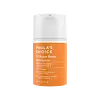What's inside
What's inside
 Key Ingredients
Key Ingredients

 Benefits
Benefits

 Concerns
Concerns

 Ingredients Side-by-side
Ingredients Side-by-side

Water
Skin ConditioningCyclopentasiloxane
EmollientEthylhexyl Isononanoate
EmollientNiacinamide
SmoothingLauryl PEG-9 Polydimethylsiloxyethyl Dimethicone
Skin ConditioningDimethicone
EmollientSalix Alba Bark Extract
AstringentSodium Chloride
MaskingPiptadenia Colubrina Peel Extract
HumectantSodium Hyaluronate
HumectantGlycerin
HumectantAllantoin
Skin ConditioningCaffeine
Skin ConditioningAscorbyl Palmitate
AntioxidantDimethicone/PEG-10/15 Crosspolymer
Butylene Glycol
HumectantPhenoxyethanol
PreservativeCapryloyl Glycine
CleansingUndecylenoyl Glycine
CleansingDisodium EDTA
Sodium Hydroxide
BufferingWater, Cyclopentasiloxane, Ethylhexyl Isononanoate, Niacinamide, Lauryl PEG-9 Polydimethylsiloxyethyl Dimethicone, Dimethicone, Salix Alba Bark Extract, Sodium Chloride, Piptadenia Colubrina Peel Extract, Sodium Hyaluronate, Glycerin, Allantoin, Caffeine, Ascorbyl Palmitate, Dimethicone/PEG-10/15 Crosspolymer, Butylene Glycol, Phenoxyethanol, Capryloyl Glycine, Undecylenoyl Glycine, Disodium EDTA, Sodium Hydroxide
Water
Skin ConditioningDicaprylyl Carbonate
Emollient3-O-Ethyl Ascorbic Acid
Skin ConditioningDimethicone
EmollientButylene Glycol
HumectantPolyglyceryl-6 Distearate
EmulsifyingAscorbyl Glucoside
AntioxidantSqualane
EmollientHydroxyethyl Acrylate/Sodium Acryloyldimethyl Taurate Copolymer
Emulsion StabilisingAcetyl Sh-Hexapeptide-5 Amide Acetate
Skin ConditioningCitrullus Lanatus Seed Oil
EmollientHydrogenated Lecithin
EmulsifyingTheobroma Cacao Seed Butter
EmollientHydrogenated Phosphatidylcholine
EmulsifyingPentaerythrityl Tetra-Di-T-Butyl Hydroxyhydrocinnamate
AntioxidantSodium Hyaluronate
HumectantOryza Sativa Bran Extract
Skin ConditioningPropanediol
SolventJojoba Esters
EmollientTocopherol
AntioxidantAcetyl Zingerone
AntioxidantCetyl Palmitate
EmollientCaprylyl Glycol
EmollientCetyl Alcohol
EmollientPolyglyceryl-3 Beeswax
EmulsifyingSodium Hydroxide
BufferingSorbitan Olivate
EmulsifyingSorbitan Palmitate
EmulsifyingHelianthus Annuus Extract
EmollientEthylhexylglycerin
Skin ConditioningHexylene Glycol
EmulsifyingSodium Phytate
Polysorbate 60
EmulsifyingSorbitan Isostearate
EmulsifyingLecithin
EmollientRosmarinus Officinalis Leaf Extract
AntimicrobialGlycine Soja Oil
EmollientLysolecithin
EmulsifyingBacillus Ferment
Skin ConditioningCitric Acid
BufferingPolyglutamic Acid
Skin ConditioningBeta-Sitosterol
Emulsion StabilisingPhytic Acid
Squalene
EmollientPhenoxyethanol
PreservativeSodium Benzoate
MaskingPotassium Sorbate
PreservativeWater, Dicaprylyl Carbonate, 3-O-Ethyl Ascorbic Acid, Dimethicone, Butylene Glycol, Polyglyceryl-6 Distearate, Ascorbyl Glucoside, Squalane, Hydroxyethyl Acrylate/Sodium Acryloyldimethyl Taurate Copolymer, Acetyl Sh-Hexapeptide-5 Amide Acetate, Citrullus Lanatus Seed Oil, Hydrogenated Lecithin, Theobroma Cacao Seed Butter, Hydrogenated Phosphatidylcholine, Pentaerythrityl Tetra-Di-T-Butyl Hydroxyhydrocinnamate, Sodium Hyaluronate, Oryza Sativa Bran Extract, Propanediol, Jojoba Esters, Tocopherol, Acetyl Zingerone, Cetyl Palmitate, Caprylyl Glycol, Cetyl Alcohol, Polyglyceryl-3 Beeswax, Sodium Hydroxide, Sorbitan Olivate, Sorbitan Palmitate, Helianthus Annuus Extract, Ethylhexylglycerin, Hexylene Glycol, Sodium Phytate, Polysorbate 60, Sorbitan Isostearate, Lecithin, Rosmarinus Officinalis Leaf Extract, Glycine Soja Oil, Lysolecithin, Bacillus Ferment, Citric Acid, Polyglutamic Acid, Beta-Sitosterol, Phytic Acid, Squalene, Phenoxyethanol, Sodium Benzoate, Potassium Sorbate
 Reviews
Reviews

Ingredients Explained
These ingredients are found in both products.
Ingredients higher up in an ingredient list are typically present in a larger amount.
Butylene Glycol (or BG) is used within cosmetic products for a few different reasons:
Overall, Butylene Glycol is a safe and well-rounded ingredient that works well with other ingredients.
Though this ingredient works well with most skin types, some people with sensitive skin may experience a reaction such as allergic rashes, closed comedones, or itchiness.
Learn more about Butylene GlycolDimethicone is a type of synthetic silicone created from natural materials such as quartz.
What it does:
Dimethicone comes in different viscosities:
Depending on the viscosity, dimethicone has different properties.
Ingredients lists don't always show which type is used, so we recommend reaching out to the brand if you have questions about the viscosity.
This ingredient is unlikely to cause irritation because it does not get absorbed into skin. However, people with silicone allergies should be careful about using this ingredient.
Note: Dimethicone may contribute to pilling. This is because it is not oil or water soluble, so pilling may occur when layered with products. When mixed with heavy oils in a formula, the outcome is also quite greasy.
Learn more about DimethiconePhenoxyethanol is a preservative that has germicide, antimicrobial, and aromatic properties. Studies show that phenoxyethanol can prevent microbial growth. By itself, it has a scent that is similar to that of a rose.
It's often used in formulations along with Caprylyl Glycol to preserve the shelf life of products.
Sodium Hyaluronate is hyaluronic acid's salt form. It is commonly derived from the sodium salt of hyaluronic acid.
Like hyaluronic acid, it is great at holding water and acts as a humectant. This makes it a great skin hydrating ingredient.
Sodium Hyaluronate is naturally occurring in our bodies and is mostly found in eye fluid and joints.
These are some other common types of Hyaluronic Acid:
Learn more about Sodium HyaluronateSodium Hydroxide is also known as lye or caustic soda. It is used to adjust the pH of products; many ingredients require a specific pH to be effective.
In small amounts, sodium hydroxide is considered safe to use. However, large amounts may cause chemical burns due to its high alkaline.
Your skin has a natural pH and acid mantle. This acid mantle helps prevent harmful bacteria from breaking through. The acid mantle also helps keep your skin hydrated.
"Alkaline" refers to a high pH level. A low pH level would be considered acidic.
Learn more about Sodium HydroxideWater. It's the most common cosmetic ingredient of all. You'll usually see it at the top of ingredient lists, meaning that it makes up the largest part of the product.
So why is it so popular? Water most often acts as a solvent - this means that it helps dissolve other ingredients into the formulation.
You'll also recognize water as that liquid we all need to stay alive. If you see this, drink a glass of water. Stay hydrated!
Learn more about Water